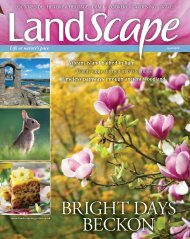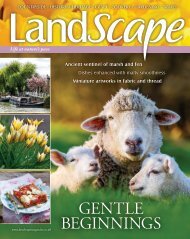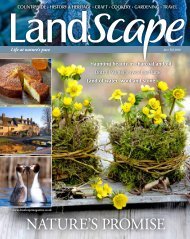Bird Watching Mini Mag
Check out Britain's best-selling bird watching magazine - Bird Watching
Check out Britain's best-selling bird watching magazine - Bird Watching
Create successful ePaper yourself
Turn your PDF publications into a flip-book with our unique Google optimized e-Paper software.
WIN!<br />
A BIRDING HOLIDAY WORTH OVER £2000<br />
UK BIRD SIGHTINGS:<br />
ALL THE SPRING MIGRANTS<br />
FROM YOUR AREA<br />
BRITAIN’S BEST-SELLING BIRD MAGAZINE<br />
PHOTO SPECIAL:<br />
The wonder of waterholes,<br />
with top photographer<br />
David Tipling<br />
JUNE 2016 £4.20<br />
SAMPLE<br />
Bee-eaters!<br />
Breeding<br />
hopes for UK<br />
create a buzz<br />
Why there’s<br />
much more to<br />
woodpeckers<br />
than just<br />
drumming<br />
GO BIRDING IN MALLORCA!<br />
Target birds, including Eleonora’s Falcon, Black Vulture & Hoopoe<br />
Guides to the best sites Discover the island’s hidden treasures
FIVE TO FIND in June<br />
THIS MONTH WE are<br />
dibbling unashamedly<br />
into the realms of the<br />
rare and scarce for the<br />
five birds for which to<br />
search. All of our regular summer<br />
visitors will be on territory during<br />
the month, with plenty to occupy<br />
the long days of midsummer.<br />
But here are a few which may<br />
require some special effort to catch<br />
up with. Some are much easier to<br />
hear than see; so, enjoy the weird<br />
and wonderful sounds, even if you<br />
don’t see the curious creatures<br />
producing them.<br />
RARITY RATINGS<br />
Common, widely distributed<br />
Localised – always a treat<br />
Very scarce or rare<br />
TELL US WHAT YOU’VE SEEN!<br />
twitter.com/<strong>Bird</strong><strong>Watching</strong><strong>Mag</strong><br />
facebook.com/<strong>Bird</strong><strong>Watching</strong><strong>Mag</strong><br />
RED-NECKED PHALAROPE<br />
QUAIL<br />
This beautiful wader is surprisingly tiny, especially for<br />
a bird which spends most of its time swimming. There<br />
are fewer than 30 pairs breeding in the country, most<br />
famously on Fetlar, Shetland, but also in the Hebridean<br />
islands. However, June sees a small but definite passage<br />
of birds through the rest of the UK, so keep an eye out on<br />
suitable wader habitat, especially where there is a pool<br />
for a phalarope to swim in. Phalaropes are highly unusual<br />
among British birds in that the females<br />
are the most brightly coloured ones,<br />
and the duller males are the ones<br />
that do the nest duties (apart from<br />
the egg-laying, of course).<br />
FLPA / Alamy<br />
The tiny Quail is one of the birds that few people actually get<br />
to see, though the ‘wet-my-lips’ song of the male is well known,<br />
emanating from deep within a grain field. Unusually for<br />
a gamebird, the Quail is migrant, coming to the UK as a<br />
summer visitor, from May onwards. It only comes in small<br />
numbers (often fewer than 500 singing males), though, spread<br />
thinly across the country. Like several other birds which are<br />
rarely seen but more often heard, it is predominantly<br />
a night-singer, often starting off as the sun falls.<br />
If you don’t mind not actually seeing a bird, the Quail<br />
present a good opportunity for finding your own scarce<br />
bird, just occasionally rewarding evening drives and<br />
pauses to listen.<br />
Did you<br />
know?<br />
Quails reach sexual maturity<br />
remarkably quickly. So quickly,<br />
in fact, that birds hatched in<br />
the spring breed later in<br />
the same summer<br />
All Canada Photos / Alamy<br />
SPOTTED CRAKE<br />
If you thought that the Water Rail was an elusive bird, then<br />
the Spotted Crake is simply invisible, at least during the<br />
breeding season. They are most frequently seen as juveniles,<br />
having dispersed in the late summer. However, now is the time<br />
to hear their distinctive song, which is usually described as<br />
a loud, repeated ‘whip!’.<br />
Males don’t start singing until late in the day, when it is<br />
already pretty dark, and the sound emanates from ditch-side<br />
vegetation or a vegetated marsh, so don’t expect even a glimpse.<br />
There are only about 80 singing males in the country, at<br />
selected sites from southern England to northern Scotland, so<br />
find a suitable site to listen after dark.<br />
8 June 2016
RARITY PREDICTOR<br />
Buiten-Beeld / Alamy<br />
NIGHTJAR<br />
This is one night bird which at<br />
least you have a chance of<br />
seeing, emerging from daytime<br />
roosting sites, where it sits<br />
invisible, wrapped in<br />
immaculate cryptic camouflage.<br />
They are, of course, night birds,<br />
emerging in the crepuscular<br />
hours of the evening, though<br />
often only showing themselves<br />
when you are about to give up<br />
and go home. Only males sing<br />
the distinctive, beautiful<br />
purring song, as well as<br />
croaking out a curious ‘koowick’<br />
call and occasionally wingclapping<br />
in display. Males are<br />
also the only ones with white<br />
wing patches and white corners<br />
to the tail. Both genders have a<br />
beautiful, buoyant flight, like a<br />
small delicate falcon on strings.<br />
MARSH WARBLER<br />
Everyone knows that Starlings and<br />
Song Thrushes mix mimicry with<br />
their songs. But the real king of the<br />
mimics among ‘British’ birds is the<br />
Marsh Warbler. The song is<br />
incredibly rich and beautiful and<br />
jammed with bird songs and calls<br />
picked up during the bird’s travels<br />
through Europe and Africa.<br />
Some of the birds you will recognise,<br />
others will be mysteries. But,<br />
whatever you hear will be just about<br />
indistinguishable from the real thing.<br />
Marsh Warblers are very similar in<br />
appearance to Reed Warblers, but the<br />
song should be enough to identify<br />
the bird. The only problem is that<br />
they are very rare breeding birds<br />
in the UK,<br />
with fewer<br />
than 10<br />
pairs,<br />
mainly<br />
confined to<br />
Worcestershire<br />
and Kent.<br />
Unlike Reed<br />
Warblers, they are<br />
not tied directly to<br />
reedbeds, often<br />
singing in bushes<br />
and rank vegetation<br />
near water.<br />
imageBROKER / Alamy David Tipling Photo Library / Alamy<br />
SCOPS OWL<br />
With more than 80 accepted records,<br />
it would seem that Scops<br />
Owl is not the rarest of<br />
rarities. However, the<br />
spread of records is<br />
pretty evenly spread<br />
through to the 19th<br />
Century and a year<br />
with more than one<br />
record is unusual. Most<br />
records have come from<br />
the Northern Isles or the<br />
south-west of England, but there have<br />
been inland records, perhaps most<br />
famously, in recent years, the singing male<br />
at Thrupp, Oxfordshire in 2006 and 2007.<br />
Many, if not most, of the accepted<br />
records are for birds found dead or near<br />
death (exhausted), which is not surprising<br />
for a nocturnal bird, which is hard enough<br />
to see in its normal European range.<br />
WESTERN ORPHEAN<br />
WARBLER<br />
There have only been three<br />
accepted occurrences<br />
of Western Orphean<br />
Warbler (plus a further<br />
four which may have<br />
been Western or<br />
Eastern). These<br />
included a longstaying<br />
winter bird<br />
at St Brides,<br />
Pembrokeshire in 2013,<br />
and the year before<br />
a first-summer at Hartlepool Headland,<br />
Cleveland/Durham on 29 May. It is<br />
a large Sylvia Warbler, a bit like<br />
a giant Lesser Whitethroat.<br />
BRIDLED TERN<br />
We have been spoilt<br />
by these exotic terns<br />
returning to the<br />
north-east in recent<br />
years. Will one<br />
appear again this year?<br />
HOW DID WE DO?<br />
✓ ALPINE ACCENTOR<br />
One of our April predictions was this<br />
montane relative of the Dunnock.<br />
By early April, more than a dozen out of<br />
range Alpine Accentors had been<br />
recorded in Germany and one was in the<br />
Netherlands. So, it was no great surprise<br />
when one turned up in the UK, found at<br />
Brownwich Cliff, on the Solent coast,<br />
Hampshire, on 13 April.<br />
Blickwinkel/ Alamy<br />
Nature Photographers Ltd / Alamy<br />
Gerry Pearce / Alamy<br />
birdwatching.co.uk 9
don’t just see.<br />
NATURE DX - 8 X 25<br />
NATURE DX - 10 X 32<br />
NATURE DX - 8 X 42<br />
NATURE DX - 10 X 56<br />
NATURE DX BINOCULARS<br />
Celestron Nature DX binoculars have something to suit every user. With 8x25 and 10x25 compact<br />
models for carrying in a pocket or storing in the glove compartment of a car, through a specialist<br />
range of 8x32 and 10x32 for those of us with smaller hands and of course the regular sized 8x42<br />
and 10x42 models, to the super bright 8x56, 10x56 and 12x56 models for the discerning low light<br />
user, there is bound to be a model to suit all users.<br />
Featuring close focus down to 6.5ft, ideal for flowers and butterflies, multicoated optics for accurate<br />
colour rendition, BaK-4 Prisms for contrast and brightness and weatherproofing with a Nitrogen<br />
Purged body, to prevent fogging, Nature DX is a serious contender in every outdoor user category.<br />
So don’t just see, WATCH the amazing world around us in stunning detail with Celestron Nature DX<br />
binoculars, there is one to suit everyone!<br />
Prices range from £110-£250 depending on model selected.<br />
WATCH, DON’T JUST SEE<br />
celestron.com
NEWS WIRE<br />
ALL THE BIGGEST BIRD NEWS & EVENTS<br />
COMPILED BY: KIRK PARSONS<br />
BIRDERS SET FOR FAIR<br />
Farmland <strong>Bird</strong> Appeal set to benefit from major weekend event held in beautiful Norfolk<br />
BRITAIN’S BEST-KNOWN<br />
BIRDWATCHING county<br />
will play host to the<br />
annual two-day Norfolk<br />
<strong>Bird</strong>fair in support of<br />
conservation charities.<br />
The BTO’s Farmland <strong>Bird</strong> Appeal<br />
will benefit from this year’s event,<br />
which takes place at Mannington<br />
Hall, near Saxthorpe, Norfolk, on<br />
May 21 and 22.<br />
Set amid unspoiled countryside,<br />
it’s a spacious and scenic site, and<br />
well placed if you want to combine<br />
a visit to the fair with visits to<br />
some of the county’s most<br />
renowned birdwatching spots.<br />
There’ll be a wide range of<br />
exhibitors, including optics<br />
companies and retailers (among<br />
them Cley Spy), charities and<br />
NGOs, tour operators, artists,<br />
photographers and authors.<br />
There’ll also be lectures from the<br />
likes of the BTO, Wader Quest,<br />
Falklands Conservation, Richard<br />
Brooks (on birding in Lemnos),<br />
Yoav Perlman (on bird ID and<br />
taxonomy), Norfolk Wildlife Trust<br />
(on Norfolk’s hidden gems for<br />
wildlife), and fair organiser Robert<br />
Wilson, an award-winning<br />
photographer, on DSLR<br />
photography of birds.<br />
<strong>Bird</strong> <strong>Watching</strong> magazine will be<br />
present on both days – so come<br />
and see us for great subscription<br />
offers, if you’d like advice or help<br />
with any aspect of birdwatching,<br />
or if you just want to tell us what<br />
you like and don’t like about the<br />
magazine! There’s a wide range of<br />
activities, too, including birdringing,<br />
bird walks with the North<br />
East Norfolk <strong>Bird</strong> Club, insect<br />
identification, a wildlife trail,<br />
basket-weaving, an evening walk<br />
with the Amphibian and Reptile<br />
Rapture Photographics<br />
Group, and wildlife art painting in<br />
progress with David Ord Kerr.<br />
There’s also the announcement<br />
of the winner of the Norfolk<br />
Wildlife Photography Competition,<br />
won last year by <strong>Bird</strong> <strong>Watching</strong><br />
regular James Lowen.<br />
Refreshments include a variety<br />
of local produce and tickets are £10<br />
on the door or £8 in advance for<br />
adults, or £18 for both days on the<br />
door, and £15 in advance. A<br />
maximum of three children per<br />
adult get in free. Group bookings<br />
of 10 or more are £7 a ticket in<br />
advance only. Please note there is<br />
good disabled access. There are<br />
still vacancies for volunteers to<br />
help with car-parking and<br />
children’s craft activities – if you<br />
sign up for four hours, enjoy free<br />
access for the rest of the day.<br />
MORE INFO<br />
WHAT: The Norfolk <strong>Bird</strong> & Wildlife fair<br />
WHEN: 21 and 22 May, 2016<br />
WHERE: Mannington Hall, Saxthorpe, Norfolk NR11 7BB<br />
WEBSITE: norfolkbirdfair.com<br />
EMAIL: birdfairnorfolk@yahoo.com<br />
ç BIRDS<br />
See birds and learn<br />
about them, too, at the<br />
Norfolk <strong>Bird</strong>fair!<br />
ê SETTING<br />
The birdfair will take<br />
place at the beautiful<br />
setting of Norfolk’s<br />
Mannington Hall<br />
Rapture Photographics<br />
16 June 2016
SPECIES BEE-EATERS<br />
ê COLOURFUL<br />
The Bee-eater is a wonderful,<br />
colourful-looking bird<br />
blickwinkel / Alamy<br />
22 June 2016
CREATING A<br />
BUZZ!<br />
The Bee-eater could soon become a regular British breeder<br />
WORDS: IAN PARSONS<br />
birdwatching.co.uk 23
SPECIES BEE-EATERS<br />
The Bee-eater is a gem of a bird, the beautiful colours of its<br />
plumage giving it truly exotic looks and, indeed, it’s a species<br />
that British birdwatchers have long thought of as ‘exotic’,<br />
a bird of foreign shores, rather than our own. However,<br />
recent events mean that this species is no longer quite as<br />
exotic as it looks. Bee-eaters are seen in Britain every year<br />
but, generally, only as scarce passage visitors. There were<br />
a couple of cases of breeding last century, a failed attempt<br />
in 1920, a successful one in 1955. But these are the exception.<br />
Then, in 2002, a pair bred in County Durham.<br />
This was followed by two failed breeding attempts<br />
in 2005 and 2006 (in Herefordshire and Dorset<br />
respectively) and then the much publicised<br />
successful breeding of two pairs on the Isle of<br />
Wight in 2014.<br />
Last year, a pair nested at Low Gelt sand quarry,<br />
near Brampton in the Cumbrian North Pennines.<br />
So, in the last 10 to 15 years, the breeding, or<br />
attempted breeding, of this beautiful bird in<br />
Britain, while still remaining a very rare event,<br />
has become much more regular. That’s leading<br />
many birders to believe (and to hope!) that it’s<br />
possible that this small, colourful migrant could<br />
become a regular breeder in Britain.<br />
The European Bee-eater (Merops apiaster),<br />
to give it its ‘full’ name, is one of 27 species of<br />
bee-eater found throughout the Old World from<br />
Europe to Australia, with the majority of species<br />
occurring in Africa.<br />
All of them are aerial predators of flying insects,<br />
with Hymenoptera (the bees, wasps and ants)<br />
being, by far, the preferred prey items. Our<br />
Bee-eater’s favourite prey is indeed the Honey Bee,<br />
with some studies showing that it makes up to<br />
more than 80% of the diet in Europe. Dragonflies<br />
also play an important role in the diet, with at<br />
least one study suggesting that young birds<br />
24 June 2016
è PURE ELEGANCE<br />
There are few more beautiful<br />
sights than a Bee-eater in flight<br />
ê MOSTLY EATS BEES...<br />
Much of the diet consists of bees<br />
and wasps, but they will eat a<br />
variety of other flying insects, too<br />
The Honey Bee makes<br />
up more than 80% of<br />
the Bee-eaters’ diet<br />
in Europe.<br />
An average single<br />
hive will contain<br />
about 100,000<br />
worker bees.<br />
A productive bee<br />
hive will produce up<br />
to 2,000 new<br />
workers every day.<br />
An adult Bee-eater<br />
will consume between<br />
200 and 250 worker<br />
bees a day when it is<br />
rearing young.<br />
increase their bodyweight quicker if they are fed<br />
on a mixture of both bees and dragonflies, rather<br />
than on bees alone.<br />
The birds hunt either by gliding on their<br />
triangular-shaped wings, suddenly increasing<br />
their speed to pursue a nearby insect, or by using<br />
the technique known as fly-catching, where they<br />
wait on a favoured perch, darting off it to catch<br />
any prey item that strays too close to them.<br />
Once they have caught their prey, the bird will<br />
often take it to a favoured perch, usually a dead<br />
bare branch, where it will then smear the rear<br />
end of the insect in a sideways wiping motion to<br />
dislodge the sting.<br />
Like that other birding jewel, the Kingfisher,<br />
in Extremadura in<br />
Spain, and Bee-eaters<br />
are very common there,<br />
as are beekeepers.<br />
Every spring,<br />
just after the<br />
birds have<br />
arrived, the local papers<br />
and news channels have<br />
reports featuring calls for the<br />
birds to be controlled. There is<br />
no disputing the fact that these<br />
beautiful birds do indeed predate<br />
Honey Bees – they will often be<br />
seen hunting over the hives<br />
themselves – but what is extremely<br />
doubtful is whether they actually<br />
have any negative impact on the<br />
hives’ productivity.<br />
Several studies have shown that an adult<br />
Bee-eater will consume between 200 and 250<br />
worker bees a day when it is rearing young.<br />
This may seem a lot, but an average single hive<br />
(and more often than not there are several hives<br />
together) will contain about 100,000 worker bees,<br />
and every day a productive hive is producing 2,000<br />
new workers, more than enough to replace those<br />
being lost to a pair of Bee-eaters.<br />
The argument in areas where there are high<br />
densities of nesting Bee-eaters (which prefer to<br />
nest in colonies), is that large numbers of Beeeaters<br />
lead to much higher losses of bees. But<br />
these areas also have large numbers of bee hives<br />
producing huge numbers of new bees each day,<br />
and indeed it is highly likely that it is the large<br />
number of hives that attract the large number<br />
Wild Wonders of Europe / Varesvuo /NPL<br />
Once they have caught their prey, the bird will often take it to a<br />
favoured perch, usually a dead bare branch, where it will then smear<br />
the rear end of the insect in a sideways wiping motion<br />
to dislodge the sting<br />
Hans Dieter Brandl/FLPA<br />
Bee-eaters are tunnel-nesters. They start to<br />
excavate their nest tunnel during the first part of<br />
May. It looks like a flattened oval at the entrance,<br />
and these tunnels can be about a metre in length.<br />
The bird digs these in exposed sandy banks,<br />
taking up to 20 days to chisel away at the substrate<br />
with its bill, and excavating up to 80 times its own<br />
body weight.<br />
Sometimes, though, this hard work can be in<br />
vain. Many nests are located on low, exposed<br />
sandy faces, sometimes no more than a few<br />
centimetres higher than surrounding ground level.<br />
This makes them extremely vulnerable to grounddwelling<br />
predators such as snakes, while the<br />
sandy soils mean that other, larger predators find<br />
it relatively easy to dig out the nest to take the<br />
young or eggs. Despite these losses, though, the<br />
Bee-eater is holding its own in Europe, with<br />
a relatively stable population, that is gradually<br />
expanding northwards in its range.<br />
Bee-eaters, as we’ve already seen, do exactly<br />
what their name suggests; they eat bees. This<br />
has often brought them into conflict with man,<br />
particularly beekeepers. I spend much of the year<br />
è KINGFISHER RELATIVE<br />
The general shape, rich colours (and the structure of the foot) all betray the<br />
Bee-eater’s close relationship to rollers and kingfishers<br />
Giulio Ercolani / Alamy<br />
birdwatching.co.uk 25
SPECIES BEE-EATERS<br />
of Bee-eaters to the area in the first place.<br />
No scientific study has ever shown that Beeeaters<br />
have a negative impact on bee hives, so the<br />
beekeepers of Britain don’t need to be worried<br />
about our new arrival. In fact, it is just possible<br />
that they may even benefit from their presence.<br />
One Spanish beekeeper I spoke with was<br />
convinced that Bee-eaters at a low density actually<br />
helped keep his many hives healthy; he believed<br />
that they selected bees that weren’t healthy,<br />
targeting the ones that had heavy mite<br />
infestations; his exact words were “they clean the<br />
hives”. One mite in particular has caused serious<br />
problems for British beekeepers. The appropriately<br />
named Varroa destructor spreads various viruses<br />
between the bees, leading to epidemics that can<br />
cause bee numbers in hives to collapse. In that<br />
light the Spanish beekeeper’s thoughts are<br />
certainly very interesting. I can’t prove he’s right,<br />
but they do make sense, ecologically.<br />
Predators the world over, be they Wolves in the<br />
Arctic or Lions in Africa, select weaker prey when<br />
hunting. There is also plenty of evidence to<br />
suggest that when an animal has a high parasitic<br />
load it has low reaction speeds and is more likely<br />
to find itself in peril – studies have shown that<br />
deer killed on our roads more often than not have<br />
high parasitic loading; in other words, they aren’t<br />
very well. Does this ecological fact apply to<br />
insects? I don’t know, but it is certainly an<br />
intriguing theory that merits further investigation.<br />
One thing I am certain of, though, is that our<br />
new potential colonisers are truly beautiful birds.<br />
How great is it to be able to think that one day in<br />
the next few years, you may find a pair of Beeeaters<br />
on your patch? I’ve seen lots of Bee-eaters,<br />
but I can’t wait to finally be able to watch them in<br />
the British countryside.<br />
Courtship feeding with a<br />
hapless copper butterfly<br />
Coming in to land, a Bee-eater<br />
reveals its coppery underwings<br />
Bee-eaters nest colonially in<br />
deep tunnels burrowed into<br />
muddy or sandy banks<br />
Wild Wonders of Europe / Varesvuo / NPL<br />
Roger Powell / NPL<br />
Stelian Porojnicu / Alamy Stock Photo<br />
26 June 2016
Alamy<br />
Alamy<br />
6<br />
MORE<br />
BEE-EATERS<br />
Alamy<br />
?<br />
DID YOU KNOW...<br />
The long process of nest-building<br />
both blunts and shortens a<br />
bee-eater’s bill. Despite this,<br />
nestholes are generally only<br />
used once.<br />
Alamy<br />
FLPA<br />
LITTLE GREEN<br />
BEE-EATER<br />
Widely distributed across<br />
sub-Saharan Africa and parts<br />
of Asia, and with a number of<br />
subspecies, this smallish<br />
bee-eater is often found in<br />
urban and suburban<br />
habitats.<br />
BLUE-BEARDED<br />
BEE-EATER<br />
Found in the Indian subcontinent<br />
and south-east Asia, this large<br />
bee-eater has a large, sickleshaped<br />
bill and a tail that lacks<br />
the protruding central ‘wires of<br />
most other members of<br />
the family.<br />
PURPLE-<br />
BEARDED BEE-EATER<br />
Endemic to the Indonesian island<br />
of Sulawesi, this species is in a<br />
genus, Meropopon, of its own. Not<br />
as brightly coloured as some<br />
bee-eaters, they nonetheless have<br />
a purple-blue ‘beard’ of shaggy<br />
throat feathers.<br />
Alamy<br />
MORE INFO<br />
Bee-eaters are a widespread bird across the<br />
Mediterranean region, and Mallorca has a good<br />
breeding population – see our 16-page centre<br />
section for details of how to find them, and many<br />
more superb birds, on the island’s reserves.<br />
SOUTHERN<br />
CARMINE BEE-EATER<br />
Found throughout sub-equatorial<br />
Africa, these gorgeous birds can<br />
often be seen circling near the<br />
edge of wildfires, picking off the<br />
escaping insects, or perched on<br />
the backs of large animals, before<br />
hawking for prey.<br />
WHITE-<br />
THROATED BEE-EATER<br />
Found mainly in semi-desert<br />
along the southern edge of the<br />
Sahara, this species doesn’t feed<br />
on bees quite as much as some<br />
others – instead, beetles and ants<br />
probably form a much greater<br />
part of its diet.<br />
RAINBOW<br />
BEE-EATER<br />
Australia’s only bee-eater species,<br />
spending the summer in the<br />
southern part of the country<br />
(excluding Tasmania), and<br />
migrating to the north and to<br />
New Guinea and Indonesia<br />
in the winter.<br />
?<br />
DID YOU KNOW...<br />
Bee-eaters spend about 10% of<br />
each day in ‘comfort activities’ -<br />
bathing, dust bathing, preening,<br />
and sunning themselves.<br />
These are often performed<br />
communally, too.<br />
Markus Varesvuo / NPL<br />
birdwatching.co.uk 27
CHALLENGE<br />
JUNE: SONG FLIGHTS<br />
ID<br />
EVERY EXTANT BRITISH bird has the power of flight. So, it is<br />
hardly surprising that some of them employ this flight as a means<br />
to broadcast their songs far and wide. If they can add a bit of<br />
flourish and a visual element, with unusual flight techniques, then all the<br />
better. Some birds, notably the Sky Lark, take the whole song flight thing<br />
to extremes, spending extended periods high in the air belting out their<br />
song. Others, such as some raptors, use display flights as a primary visual<br />
performance, usually with simple yelps and mews as the accompaniment.<br />
It is, however, only selected birds which use flight combined with sound<br />
for their displays, which at least helps with identification. Have a try at<br />
identifying these birds captured in the middle of the display flight. Then<br />
turn for the solutions and turn again for more ID tips.<br />
BIRD 1 BIRD 2<br />
BIRD 1<br />
WHAT AM I?<br />
Nature Photographers Ltd / Alamy<br />
Graham Catley / Alamy<br />
BIRD 2<br />
WHAT AM I?<br />
BIRD 3 BIRD 4<br />
BIRD 3<br />
WHAT AM I?<br />
BIRD 4<br />
FLPA / Alamy Duncan Usher / Alamy<br />
BIRD 5 BIRD 6<br />
FLPA / Alamy<br />
imageBROKER / Alamy<br />
BIRD 5<br />
BIRD 6<br />
WHAT AM I?<br />
WHAT AM I?<br />
WHAT AM I?<br />
TURN OVER TO FIND OUT<br />
IF YOU birdwatching.co.uk ARE CORRECT! 39
JUNE ID CHALLENGE<br />
SONG FLIGHTS<br />
How did you do?<br />
Long tail with white<br />
outer feathers<br />
Grey-brown<br />
plumage<br />
White throat<br />
Broken white eyering<br />
BIRD 1<br />
Here we have an essentially grey or grey-brown bird with a thin, insect-eater’s<br />
bill, rounded wings and a long tail. Also obvious is the fact that the ‘puffy’<br />
throat is clean white, contrasting with the buffer tones of the breast and belly.<br />
And, while examining the head, note the broken white eye-ring and, if you<br />
look very closely, you may see that the shaded iris is not dark. The long grey<br />
tail has white outer tail feathers. The structure of the bird suggest a pipit or a<br />
warbler. Its unstreaked underparts should steer you away from our pipits or<br />
the streaked Sedge Warbler, which does sing in flight. It appears to be one of<br />
the whitethroats. Lesser Whitethroats don’t sing in flight and have darker bills<br />
and eyes and shorter tails. This is a Whitethroat.<br />
KEY FEATURES<br />
Thin bill and rounded wings suggests small insect-eater<br />
Overall grey brown plumage and white throat<br />
Yellowish base to bill, white eye-ring ‘pale’ eye<br />
Long tail with white outer tail feathers<br />
BIRD 2<br />
In some ways this bird, singing in flight over a reedbed, is similar to <strong>Bird</strong> 1,<br />
having short rounded wings and a thin insect-eater’s bill. Look again and you<br />
will see that the structure is subtly different, this bird having a much shorter<br />
rounded tail. Even more obvious, though, is that this bird has a very bold pale<br />
supercilium (‘eyebrow’) with a dark stripe above it, and the warm brown<br />
plumage, particularly of the upperparts, is streaked or spotted. The breast<br />
and flanks are pretty ‘clean’, however, unlike a pipit or lark, which would be<br />
streaked. This bird looks like a streaked warbler and the pattern and structure<br />
should point you towards Sedge Warbler, one of the few warblers that has a<br />
song flight. The reeds are a typical Sedge Warbler habitat.<br />
KEY FEATURES<br />
Small brown bird (compare reed heads)<br />
Hint of streaking on upperparts<br />
Obvious, bold, pale supercilium and dark lateral crown stripe<br />
Shortish, rounded tail<br />
Short rounded tail,<br />
short rounded wings<br />
Streaky plumage<br />
Pale supercilium<br />
and dark lateral<br />
crown stripe<br />
Streaked breast,<br />
finer flank streaking<br />
Massive tertials<br />
Relatively short,<br />
curved rear claw<br />
BIRD 3<br />
Yet another thin-billed small bird, which immediately makes you think of<br />
warblers or pipits. The dangly legs with long claws and very long tertial<br />
feathers (the wing feathers at the trailing edge, close to the body) plus the<br />
streaked breast, should all point to this being a singing pipit. We have three<br />
breeding pipits in the UK, all of which perform ‘similar-looking’ song flights.<br />
Rock Pipit is the darkest, with heavy, smudgy breast- and flank- streaking<br />
(and dark legs). The Meadow and Tree Pipits are more similar. However,<br />
Meadow Pipit can be ruled out here by the much finer flank streaking than<br />
breast streaking, the ‘short’, curved rear claws and the face pattern, including<br />
a dark line through the eye, and a pale cheek spot. This is a Tree Pipit.<br />
KEY FEATURES<br />
Streaked breast gives pipit appearance<br />
Larger breast streaks, finer flank streaks<br />
Dark eyestripe, bold pale half-ring above eye<br />
Dangling feet showing relatively short curved rear claw<br />
40 June 2016
MY FAVOURITE SITE...<br />
“I have long declared my love for the<br />
Nene Washes, Cambs, where song<br />
flights of waders, larks, pipits and<br />
warblers are part of a typical spring<br />
or summer walk.”<br />
Mike Weedon, assistant editor<br />
SNAP IT!<br />
And send it to<br />
birdwatching@<br />
bauermedia.co.uk<br />
NEXT MONTH<br />
Juvenile wader ID<br />
Alamy<br />
Long wings<br />
Band of breast streaking<br />
White outer tail feathers<br />
BIRD 4<br />
Oh no, yet another pipit, you may be thinking. But there is something about<br />
that relatively small head which suggests a larger, almost thrush-sized bird.<br />
Those wings look long and the bird in general looks to have a robust, almost<br />
chunky, weighty build. This bird has the structure of a lark. We have two<br />
breeding lark species in the UK: the Sky Lark and the scarce Wood Lark,<br />
both of which perform song flights. The latter is notably short-tailed and has<br />
relatively short, rounded wings. But this bird has long wings and a long, full<br />
tail for a lark. Crucially, it also has white outer tail feathers, and you can just<br />
make out a white trailing edge to the inner flight feathers, both of which rule<br />
out Wood Lark (which has white tail tips) . This is a Sky Lark.<br />
KEY FEATURES<br />
Head looks ‘small’ implying a decent-sized bird<br />
Long, broad wings<br />
Dense band of fine streaks across breast<br />
Full, broad tail with white outer feathers<br />
BIRD 5<br />
Here we have a twist in the tale, as at last, this bird is obviously not a warbler,<br />
pipit or lark. The very long narrow straight bill immediately points to this<br />
being a wader, a conclusion only enhanced by the long pointed wings. In this<br />
case the bill is so long, the bird can only be a snipe, Woodcock, godwit or<br />
one of the rare dowitchers. But this bird is very well marked with streaks and<br />
stripes, with a dark rump, so godwits and dowitchers can be dismissed. A key<br />
feature lacking in Woodcock and Jack Snipe is at the tail. The two outermost<br />
feathers are uniquely spread from the rest of the tail. Passing air causes these<br />
feathers to resonate to produce the renowned drumming of the Snipe.<br />
KEY FEATURES<br />
Very long, straight bill, unmistakably a wader<br />
Long pointed wings also point to wader<br />
Heavily and boldly streaked with pale back lines<br />
Diagnostic spread outer tail feathers<br />
Heavily striped<br />
plumage<br />
Unique spread<br />
outer tail feathers<br />
Extremely<br />
long, straight bill<br />
Red base to straight<br />
medium-long bill<br />
White trailing band<br />
Long red legs<br />
and feet<br />
BIRD 6<br />
We end with another wader, as betrayed by the medium-long straight bill,<br />
which is wide open, shouting out the ‘song’ and the long pointed wings. The<br />
slim neat bill and straight bill imply this is a Tringa sandpiper. And there are<br />
lots of ID pointers which make specific identification straightforward. Firstly,<br />
the overall plumage is brown streaks and spots on a white background. Then,<br />
you will notice the long red legs, with feet protruding beyond the tail (which<br />
in Tringa terms, narrows it down to Redshank or Spotted Redshank). The bill<br />
base of both mandibles is red and the wings show a translucency in the<br />
trailing quarter, implying a broad white band there on the upper surface. This<br />
can only be a Redshank.<br />
KEY FEATURES<br />
Mid-long, straight bill and long wings imply this is a wader<br />
Overall brown plumage, with heavily streaking on white<br />
Long red legs and feet protrude beyond tail<br />
Red bill base and broad white trailing edge diagnostic<br />
birdwatching.co.uk 41
JUNE ID CHALLENGE<br />
SONG FLIGHTS<br />
ID tips & tricks<br />
TOP TIP!<br />
The crepuscular<br />
hours are the best<br />
time to look and listen<br />
for roding Woodcock<br />
flying over their<br />
territory<br />
Chris Gomersall / Alamy<br />
blickwinkel / Alamy<br />
Most of our breeding waders use display flights to get across their<br />
message of territorial ownership and attract the opposite sex. The Snipe<br />
has its magic drumming, the Woodcock its crepuscular croaking and<br />
squeaking flight called ‘roding’, Lapwings have tumbling flapping flight<br />
with added electronic sounding calls, and birds such as Redshanks have<br />
flicky-winged attention-seeking song flights. Even larger waders such as<br />
Black-tailed Godwits have song flights, in the latter’s case consisting of a<br />
very high sideways rocking flight, almost pretending that they have<br />
forgotten how to fly properly, while yelping out the raptor like ‘godwit,<br />
godwit’<br />
call.<br />
Lapwing<br />
TO FLY OR NOT TO FLY<br />
Many birds which incorporate song flights into their territorial<br />
display will also sing from a perch or from the ground. Even that<br />
most famed of aerial songsters, the Sky Lark, will deliver its song<br />
from a perch on occasion, though the ‘high altitude’ far-reaching<br />
broadcast of the Sky Lark’s song is much more effective at<br />
covering a wide area of territory. The Wood Lark, on the other<br />
hand, will readily sing from a high perch or from song flight from up<br />
to 150m altitude. Similarly, Tree Pipits sing from a high perch,<br />
usually continuing the song rising up singing, before parachuting<br />
slowly down with their feet dangling below.<br />
Few of our warblers opt to use a song flight, with the notable<br />
exceptions of the Whitethroat and the Sedge Warbler. Both<br />
these species will also readily sing from a perch, almost using the<br />
song flight as an occasional added extra. Awareness of which<br />
species employ song flights is a useful ID tool.<br />
Wood Lark<br />
Few of our warblers opt to use a song flight, with the<br />
notable exceptions of the Whitethroat and the Sedge<br />
Warbler. Both these species will also readily sing from a<br />
perch, almost using the song flight as<br />
WADER DISPLAY FLIGHTS<br />
an occasional added extra<br />
Woodcock<br />
Black-tailed Godwit<br />
Arterra Picture Library<br />
blickwinkel / Alamy<br />
Sedge Warbler<br />
SKY DANCING RAPTORS<br />
Masters of the air, raptors, particularly the broad-winged birds of<br />
prey, are also kings of the display flight. Particularly in the case of<br />
the harriers, the spectacular slow-motion rowing wing beats from<br />
great heights, interspersed with extreme rollercoaster dives and<br />
twists, are among the great spectacles of the birding world.<br />
Hen Harrier<br />
Christian Hutter / Alamy Avico Ltd / Alamy<br />
42 June 2016
COLLECT<br />
& KEEP<br />
Every month we bring<br />
you 10 more sites to<br />
build up your<br />
GO BIRDING<br />
collection<br />
GO BIRDING<br />
THE BEST PLACES IN BRITAIN TO WATCH BIRDS<br />
FORSINARD FLOWS RSPB<br />
Take a look at a truly unique habitat for the<br />
UK, with plenty of rare breeding birds<br />
1<br />
LOCH AN EILEIN<br />
Search for Caledonian forest specialists,<br />
like Crested Tit on this summer walk<br />
2<br />
WOODSIDE<br />
Find Pied Flycatchers and more in this<br />
classic piece of western woodland<br />
MORE<br />
SITES<br />
For a full list<br />
of the sites we’ve<br />
featured, go to<br />
birdwatching.<br />
co.uk/gbindex<br />
PLANTATION WOOD<br />
Discover a great<br />
mixture of<br />
wetland and<br />
woodland species<br />
at this easily<br />
walkable site<br />
PRIORY GROVES<br />
Dipper and Grey wagtail are among the<br />
target birds along this riverside trail<br />
3<br />
YORK<br />
Look for Peregrines and more around<br />
the city’s most historic buildings<br />
THORNDON CP<br />
Kingfishers are among<br />
the highlights of this<br />
green urban oasis<br />
KEY<br />
Sites may be best visited by car, or a car may<br />
be required to get from point to point.<br />
Requires birding to be done on foot.<br />
Specified points to visit, but can be done in<br />
any order (known as KEYPOINTS)<br />
Specified points to visit and are best done in<br />
numerical order (known as WAYMARKERS)<br />
NB: The MILES ON FOOT is the amount of miles you<br />
will need to walk and not necessarily the amount of miles<br />
in the whole route. The TIME is how many hours we<br />
recommend. So, if there are fewer miles per hour, it<br />
maybe that there is more to see.<br />
4<br />
RESERVE DU GROS BANC<br />
Great estuary-side birding, and rare<br />
warblers, just a short ferry trip from the UK<br />
6<br />
7<br />
ê<br />
10<br />
8<br />
5<br />
9<br />
DERSINGHAM<br />
It’s not just Nightjars<br />
– this lowland bog has<br />
owls, Wood Larks and<br />
much more, too<br />
LONGROPE WOOD<br />
Mature woods mean Marsh Tit and Lesser<br />
Spotted Woodpecker are target birds<br />
birdwatching.co.uk 45
SITE 6 BRECONSHIRE //<br />
MILES ON FOOT: 2 TIME: 1 HOURS<br />
PRIORY GROVES<br />
Find great woodland birds in a historic and tranquil setting<br />
SITE STATS<br />
blickwinkel / Alamy<br />
ACAUSE OF some confusion is<br />
the fact there are two rivers<br />
called Afon Honddu in<br />
Breconshire, one in the east of the<br />
county, in the Vale of Ewyas, the<br />
other, having risen on the high<br />
ground of the Mynydd Epynt, flowing<br />
southwards to join the River Usk at<br />
Brecon, fringed at the last of its<br />
11-mile journey by the woodlands of<br />
Priory Groves.<br />
Defending the rivers’ confluence is<br />
Brecon Castle, originally built by the<br />
Norman knight Bernard de<br />
Neufmarche at the end of the 11th<br />
Century after defeating the Welsh<br />
rulers of South Wales, and now a<br />
hotel and restaurant, so worth<br />
bearing in mind when planning your<br />
visit. A town quickly followed and on<br />
the higher ground, immediately<br />
overlooking the Afon Honddu,<br />
Bernard founded a church and priory,<br />
which in the Middle Ages was famed<br />
for its great golden cross, though like<br />
much else it was destroyed during the<br />
Dissolution of the Monasteries.<br />
Renewal began in the mid 19th<br />
Century, resulting in the fine<br />
cathedral seen today, which is always<br />
worth a visit and includes the<br />
enjoyment of watching Blackbirds on<br />
the surrounding lawns, and even<br />
a foraging Green Woodpecker.<br />
Extending north from the Cathedral<br />
and clinging to the steep slopes above<br />
Grey Wagtail<br />
the Afon Honddu are the Priory<br />
Groves. Many a monk in<br />
medieval times would have<br />
followed the footpath and one<br />
hopes appreciated the birds<br />
encountered. <strong>Bird</strong>s of the river,<br />
like Common Sandpiper,<br />
Kingfisher, Dipper and Grey Wagtail<br />
can be found. In the woodlands are<br />
summer visitors,<br />
like Blackcap<br />
and Chiffchaff,<br />
and the residents<br />
include Goldcrest,<br />
Nuthatch and<br />
Treecreeper.<br />
DAVID SAUNDERS<br />
KEY POINTS<br />
1A short distance from the town centre is a<br />
bridge over the Afon Honddu on which to<br />
linger and hopefully enjoy sightings of Common<br />
Sandpiper, Dipper, Grey Wagtail and Kingfisher.<br />
2Climb the hill, and note the Priory Well, a<br />
sacred spring, before taking the woodland<br />
footpath. This is Tawny Owl territory, though a<br />
late evening visit will be necessary to hear or<br />
perhaps glimpse it. The bats at such a time will<br />
include both Daubenton’s and Pipistrelle.<br />
3Our most widespread migrant warbler, the<br />
Willow Warbler, is joined by other summer<br />
visitors to the woodlands, including Chiffchaff,<br />
Blackcap and Garden Warbler. Great Spotted<br />
Woodpecker, Jay, Mistle Thrush, Nuthatch and<br />
Treecreeper are also resident.<br />
4<strong>Bird</strong>s of prey in the woodlands or overhead<br />
should be Buzzard, Red Kite and<br />
Sparrowhawk while one to look out for in the<br />
county is the Hobby.<br />
Dipper<br />
David Saunders<br />
OTHER WILDLIFE<br />
Sit quietly above the<br />
riverbank and, with<br />
patience, you may well<br />
enjoy a sighting<br />
of Otters<br />
Chris Grady / Alamy<br />
1<br />
GRID REF: SO 048 296<br />
POSTCODE: LD3 9DP (for the Brecon<br />
Cathedral Heritage Centre)<br />
HOW TO GET THERE: From east or west by<br />
way of the A40 or from the south by the A470<br />
before following signs for the Brecon centre<br />
WHERE TO PARK: A town centre car park<br />
TERRAIN: Good footpath but can be muddy,<br />
boots or walking shoes ideal<br />
ACCESSIBILITY: Open at all times<br />
FACILITIES: Everything a hungry and thirsty<br />
birdwatcher requires can be found in Brecon,<br />
including at the main car park a fine<br />
information centre and a short distance away<br />
a splendid second-hand bookshop<br />
PUBLIC TRANSPORT: Regular bus services<br />
to Brecon. Nearest rail station is Abergavenny.<br />
Traveline Cymru, tel: 0871 200 2233,<br />
travelinecymru.info<br />
ORGANISATIONS: Brecknock Wildlife Trust,<br />
Lion House, Bethel Square, Brecon, Powys<br />
LD3 7AY. Tel: 01874 625708,<br />
brecknockwildlifetrust.org.uk<br />
COUNTY RECORDER: Andrew King,<br />
andrew.king53@gmail.com<br />
WEB SITES: brecknockbirds.co.uk<br />
MAPS: OS Explorer OL 12,<br />
OS Landranger 160<br />
2<br />
4<br />
3<br />
© Crown copyright 2016 Ordnance Survey. Media 026/16<br />
birdwatching.co.uk 51
SUBSCRIBE TO<br />
AND GET TWO<br />
YEARS<br />
FOR THE<br />
PRICE OF ONE*<br />
THREE GREAT OPTIONS TO CHOOSE FROM<br />
SAVE<br />
51% *<br />
SAVE<br />
73%<br />
PRINT ONLY<br />
¿ 26 issues for £55 when you pay by<br />
credit / debit card / PayPal<br />
DIGITAL ONLY<br />
¿ 26 issues for £34 when you pay by<br />
credit / debit card / PayPal<br />
PRINT + DIGITAL<br />
¿ 26 issues for £60 when you pay by<br />
credit / debit card / PayPal<br />
8 www.greatmagazines.co.uk/BW<br />
) 01858 438884<br />
56 June 2016<br />
LINES OPEN 8AM-9.30PM (MON-FRI),<br />
8AM-4PM (SAT) QUOTE REF: FCAA
“Our mission is to bring you everything<br />
you need for a brilliant year of birding<br />
– and with this amazing offer you’ll get<br />
your favourite magazine delivered to your<br />
door for two years, instead of one!<br />
Matt Merritt, editor<br />
SUBSCRIBE TODAY<br />
Never miss an issue<br />
Free UK delivery to your door or free<br />
download to your digital device<br />
Save money on shop prices<br />
Save 73% when you choose the print<br />
and digital package option and pay by<br />
credit/debit card/Paypal<br />
vario images GmbH & Co.KG / Alamy Stock Photo<br />
TERMS AND CONDITIONS: *2 years for the price of 1 applies when you choose the print or digital only option and pay by credit/debitcard/PayPal. Subscriptions will start with the next available issue. The minimum term is 26 issues. This offer closes on 8th June 2016<br />
and cannot be used in conjunction with any other offer. Cost from landlines for 01 numbers per minute are (approximate) 2p to 10p. Cost from mobiles per minute (approximate) 10p to 40p. Costs vary depending on the geographical location in the UK. You may get<br />
free calls to some numbers as part of your call package – please check with your phone provider. Order lines open 8am-9.30pm (Mon-Fri), 8am-4pm (Sat). UK orders only. Live Overseas? Please phone +44 1858 438828 for further details. For full terms and conditions<br />
please visit: http://www.greatmagazines.co.uk/offer-terms-and-conditions<br />
birdwatching.co.uk 57
CREATE YOUR<br />
PART 6<br />
GARDEN PATCH<br />
FROM SCRATCH<br />
It’s time to invite other wildlife into editor<br />
Matt’s garden, including bees and bugs!<br />
BY MATT MERRITT<br />
TRUNK STYLE BUG HOTEL<br />
POND COMPLETE, WE’VE turned our<br />
attention to the rest of the back garden, as<br />
well as to the front. OK, I know the latter<br />
isn’t strictly within the remit of this<br />
garden patch challenge, but birds being<br />
what they are, they flit pretty readily<br />
from one to the other, so making one<br />
wildlife-friendly involves doing the same<br />
to the other, too. So, let’s get to work!<br />
First task for me was creating some<br />
bee and bug hotels. Some chunky<br />
off-cuts from our Field Maple and<br />
from a Viburnum bush were ideal for<br />
this. I cut them all to roughly the<br />
same length, and then drilled the<br />
ends with holes of a variety of sizes.<br />
These need to be reasonably deep<br />
– about 3cm – and make sure you<br />
clear the sawdust from the hole and<br />
sand off the edges so that insects<br />
don’t damage themselves going in<br />
and out. After that, I stacked them<br />
roughly in a sunny spot near the<br />
Field Maple, and now it’s just a<br />
matter of waiting to see if the holes<br />
get plugged by solitary bees.<br />
At the back, we’ve planted<br />
sunflowers, which should not only<br />
look great but also provide our<br />
visiting birds with seeds in autumn.<br />
And everything we planted last<br />
month, with the exception of the<br />
rhubarb, is doing well, too. The<br />
previous owners had left a full<br />
compost bin, and we’ve used it<br />
liberally where necessary.<br />
Throughout all the digging and<br />
weeding, incidentally, we’ve found<br />
only a couple of slugs, but a lot of<br />
Hedgehog poo – we’re pretty sure the<br />
large Hedgehog we noticed last<br />
month is visiting regularly and<br />
hoovering them up, proving just how<br />
effective natural pest control can be.<br />
Later in the summer, we’ll take a<br />
look at creating some Hedgehog<br />
refuges so that one or more can<br />
hibernate in the garden over the<br />
winter. Finally, at the front, that<br />
Viburnum I mentioned has been<br />
replaced (large parts of it were dead)<br />
with an ornamental cherry tree,<br />
while we’ve got a bit of a dilemma<br />
about a young Ash that’s clearly<br />
self-seeded in the midst of several<br />
other bushes. Do we try to move it, to<br />
give it and its neighbours the best<br />
possible chance of survival?<br />
As far as new birds are concerned,<br />
the first few Swallows have gone<br />
over, and both Chiffchaff and<br />
Blackcap have made fleeting visits to<br />
the Field Maple to sing and hopefully<br />
survey the burgeoning insect life.<br />
Throughout our days of digging,<br />
Robins were a constant presence,<br />
coming to within a couple of feet –<br />
I think we have a pair at both front<br />
and back, and there have been one or<br />
two face-offs between these fiercely<br />
territorial birds.<br />
I stacked them roughly in a sunny spot ... and<br />
now it’s just a matter of waiting to see if the holes<br />
get plugged by bees<br />
Tom Bailey<br />
68 June 2016
ê INVITING<br />
Matt’s been pruning and planting<br />
in an effort to attract even more<br />
wildlife to his garden<br />
WHAT TO DO<br />
ADRIAN THOMAS<br />
RSPB wildlife gardening expert<br />
We still have so much to learn about<br />
bats. It’s amazing to think the<br />
Soprano Pipistrelle was only<br />
separated from the Common Pipistrelle in 1997, and<br />
the Alcathoe Bat was first found in the UK in 2010,<br />
but had probably been here for decades.<br />
Only a few of our 17 species are regular garden<br />
visitors, and they need to eat thousands of flying<br />
insects! That means a garden which mimics a<br />
woodland glade, with banks of trees to provide<br />
protection from the wind, plus a pond and other<br />
insect-rich habitats, stands a good chance of being<br />
a regular stop-off during a bat’s night-time<br />
wanderings. Bat boxes are well worth putting up,<br />
too; they need to be made of untreated timber, with<br />
snug joints, and ideally with two or more cavities.<br />
Put up at different heights and facing different<br />
directions, under the eaves or on tree trunks, ideally<br />
with shelter above but a clear flightline in from<br />
below. They may only be used occasionally, but<br />
bats need that choice so they can always find<br />
the optimum conditions, whatever time of year<br />
it may be.<br />
WHAT TO GROW<br />
LIZ POTTER<br />
Editor, Garden Answers<br />
Fruit-bearing ornamental cherries are<br />
an attractive source of early blossom<br />
for pollinators and summer fruit for<br />
birds. When planting one, add in plenty of organic<br />
matter to the planting hole and water well.<br />
Add a stake at 45° to prevent any wind from rocking<br />
the plant and making the roots loose. Try to keep<br />
the lawn from encroaching on the trunk – it will<br />
compete for moisture while the young tree is<br />
getting established.<br />
You will have mulched the tree with well-rotted<br />
organic matter in late winter (February) and fed with<br />
a general<br />
fertiliser. Keep<br />
trees well<br />
watered while<br />
they’re<br />
establishing and<br />
protect the<br />
flowers from<br />
frost using a<br />
large sheet of<br />
horticultural<br />
fleece. You may<br />
not see fruit<br />
until the tree is<br />
about two to<br />
four years old.<br />
BIRDS ADDED TO<br />
OUR GARDEN LIST<br />
1. Chiffchaff<br />
2. Blackcap<br />
3. Swallow<br />
NEXT MONTH: PREPARING<br />
FOR SUMMER
GEAR<br />
NEW PRODUCTS & GREAT SAVINGS FOR ALL YOUR BIRDING NEEDS<br />
REVIEWS<br />
FINE TUNING<br />
OF A GREAT<br />
PRODUCT<br />
SWAROVSKI EL FIELDPRO 8.5x42<br />
FROM £2,000 REVIEWED BY MATT MERRITT<br />
SWAROVSKI’S EL BINOCULARS were revamped to great<br />
effect only a few years back, so the launch of the FieldPro<br />
package represents more of a fine-tuning of an already<br />
outstanding product, rather than a reinvention of any kind.<br />
So what’s new, exactly? In terms of optics, the image is still<br />
very bright and very sharp right to the edges, giving a ‘walk-in’ feel<br />
that brings a wide panorama into precise focus.<br />
The cutaway design is the same, but the rubber armour has a more<br />
‘grippy’ feel, and the focus wheel, which takes 2.5 clockwise turns<br />
from close focus (1.5m) to infinity, is easier to grip and move (very<br />
smoothly). The dioptre setting is precise and stays in place well.<br />
Extras<br />
The extras are where things have changed. The objective lens covers<br />
have a new attachment, which keeps them secure but stops them<br />
flapping about, and can be removed easily and replaced with lugs<br />
to stop the hinge getting damaged.<br />
The neoprene ‘comfort’ strap now has circular rather than flat<br />
cords at the end, making moving the rainguard much easier, and<br />
these attach quickly and simply using a twist mechanism. This<br />
enables you to switch rapidly and easily to accessories such as<br />
a floating strap (seawatchers might like this), a harness or a binoguard<br />
in the field. Finally, the length of the strap itself can be<br />
adjusted and then secured instantly using two twist controls.<br />
VERDICT<br />
A subtle but effective evolution of outstanding binoculars – the<br />
optics are the same, but the design even more user-friendly.<br />
The new attachments make the<br />
strap easier to fit or swap for<br />
other accessories such as a<br />
harness, while the length of the<br />
strap can be altered very quickly<br />
by twisting the discs on the end<br />
of the neoprene section.<br />
74 June 2016
RATINGS<br />
OPTICS êêêêê<br />
HANDLING êêêêê<br />
PRICE êêêê<br />
OVERALL êêêêê<br />
NB: Price rating reflects value for<br />
money against others in its class<br />
BIRDTRACK IOS APP VERSION 2.0<br />
REVIEWED BY JONNY RANKIN<br />
The focus wheel feels easier to<br />
grip, especially through gloves,<br />
thanks to more pronounced and<br />
harder ridges. The pullout dioptre<br />
adjuster is easy to set, and locks<br />
in place, preventing accidental<br />
movement in the field.<br />
FACTFILE<br />
Field of view (@1000m): 133m<br />
Close focus: 1.5m<br />
Eye relief: 20mm<br />
Dimensions: 160mm x 131mm x 61mm<br />
Weight: 835g<br />
RRP: £2,000<br />
Contact: uk.swarovskioptik.com<br />
LONG STANDING BIRD<br />
<strong>Watching</strong> readers may recall<br />
that I was delighted back in<br />
2013 when the <strong>Bird</strong>Track app<br />
hit the app store; indeed,<br />
I have used the app routinely<br />
ever since. This updated iOS<br />
version considerably<br />
broadens the app’s<br />
capabilities, to the extent that<br />
you can now use it globally!<br />
As well as the convenience of<br />
being able to use <strong>Bird</strong>Track<br />
while on holiday, your records<br />
now add conservation value<br />
to in-country organisations in<br />
the same way as they do here.<br />
Given the now broadreaching<br />
scope of the app,<br />
various taxonomies are available in-app. The ‘<strong>Bird</strong>Track Legacy’<br />
list is the one to go for if you are UK-based. If you travel widely,<br />
you could leave it set on the default ‘International Ornithological<br />
Congress’ list and merrily <strong>Bird</strong>Track your way around the world!<br />
When the overhauled version 2.0 hit the app store in March<br />
2016, I hit some initial stumbling blocks, all of which have now<br />
been overcome. Paying heed to the in-built help module would<br />
have largely avoided the issues I faced, but much like flat-packed<br />
DIY, who actually reads the instructions?<br />
First, under the Settings section of the app, be sure to press<br />
the blue ‘Update’ button once you have added your user details.<br />
If you have used <strong>Bird</strong>Track before, this will pull in your existing<br />
sites and allow the app to recognise your location in relation to<br />
your established nearby sites. Thereafter, the aforementioned<br />
‘<strong>Bird</strong>Track Legacy Baselist’ will ensure the familiar species’ names<br />
are in use. I am aware that some users have expressed concern<br />
over the removal of the ‘Casual’ recording tool from the app,<br />
which allows for the input of a one-off sighting. However, this<br />
functionality is still available; it is just that all records are<br />
submitted in a standardised manner. For a casual record you<br />
input in the normal way but leave the Complete List slider in the<br />
Off position. This adds value to your <strong>Bird</strong>Track records, as it<br />
avoids a collection of ‘mobile sites’ building up in your site history<br />
by ensuring all sites have a meaningful place name associated<br />
with them – a very welcome change for end-users like County<br />
Recorders! Overall, once you have set up the app, the<br />
functionality is now closer to the desktop version than ever.<br />
It is an incredibly powerful bird recording tool with the scope<br />
now broadened to allow for data entry anywhere in the world!<br />
In itself, that is a hugely impressive achievement - reducing the<br />
World and its 10,000 birds to one app. Perhaps my favourite<br />
functions are the ability to create and name sites in the field and<br />
to cumulatively add to counts of already recorded species.<br />
birdwatching.co.uk 75
UK BIRD SIGHTINGS MARCH<br />
SOUTH WEST<br />
Highlights In association with<br />
Two species of North<br />
American gull were<br />
perhaps the rarest ‘newer’ birds. There<br />
were potentially two adult Franklin’s<br />
Gulls in Cornwall, at Siblyback<br />
Reservoir and later in the month at<br />
Walmsley Sanctuary. And, in Devon,<br />
there was an adult Bonaparte’s Gull,<br />
once more at Dawlish Warren NNR.<br />
AVON<br />
HIGHLIGHTS: First dates included Sand<br />
Martin (14th), Wheatear (20th), Swallow and<br />
White Wagtail (21st), Little Ringed Plover<br />
(22nd), House Martin (25th), Willow Warbler<br />
(30th) and a very early Hobby (31st).<br />
PORTISHEAD AND CLEVEDON AREA:<br />
There was a Red-breasted Merganser (7th),<br />
Goosanders (13th and 23rd), 23 Common<br />
Scoters (30th), two Little Ringed Plovers<br />
(30th), four Ruff, ten Purple Sandpipers, a<br />
Black Redstart (4th), with two (12th), and six<br />
Crossbills (29th).<br />
SEVERNSIDE: At the start of the month there<br />
were good numbers of Kittiwakes. There was a<br />
Little Gull (13th), with four (15th), 55 Brent<br />
Geese (22nd) and eight Common Scoters plus<br />
two Gannets (28th). Avocets were seen (11th<br />
and 20th). Four Little Ringed Plovers, three<br />
Ruff, a Marsh Harrier (14th), Short-eared Owl,<br />
five Crossbills (23rd) and four Water Pipits were<br />
noted.<br />
THE RESERVOIRS: Blagdon held a<br />
Black-necked Grebe all month and an<br />
unexpected Jack Snipe (21st). Chew had a<br />
Slavonian Grebe (29th-30th), Black-necked<br />
Grebe (22nd and 26th), nine Common Scoters<br />
(19th), an early Osprey (24th) and a Ring-billed<br />
Gull (5th). There was a Kittiwake (12th), a Little<br />
Gull and Sandwich Tern (28th), Firecrest (10th)<br />
and four Bearded Tits (25th).<br />
WESTON-SUPER-MARE: The estuary held 21<br />
Common Scoters, two Eiders, four Gannets and<br />
a Sandwich Tern (28th), and three Goosanders<br />
(29th). There was an Avocet (22nd-23rd),<br />
Firecrest (22nd) with two (23rd) and a Marsh<br />
Harrier (23rd).<br />
OTHER SITES: The spring Red Kite passage<br />
saw birds at Oldbury Power Station (2nd),<br />
Northwick (two on 4th, 14th and 15th),<br />
Kingston Seymour (two on 13th), Sheppardine<br />
and Aust (14th), Walton Common (15th), Chew<br />
(15th and 16th), Folly Farm (16th), Redland<br />
(18th), Durdham Down and Bishopston (21st),<br />
Chipping Sodbury (21st and 28th), Abbots<br />
Leigh (22nd), Weston-super-Mare (22nd and<br />
23rd), Shockerwick and Portishead (23rd) and<br />
St Andrews, Bristol (25th).<br />
Oldbury Power Station held a Short-eared<br />
Owl and Water Pipit (11th), Black Redstart<br />
(13th), Scandinavian Rock Pipit (22nd) and<br />
Sandwich Tern (28th). Three Cranes flew over<br />
Thornbury (15th), with two over New Passage<br />
(17th) and six over Congresbury (21st). A<br />
Firecrest remained in Eastville Park, Bristol (to<br />
12th). A Smew was at Chipping Sodbury (12th).<br />
Richard Mielcarek<br />
CHANNEL ISLANDS<br />
GUERNSEY: Great Northern Diver, Slavonian<br />
Grebe, Great Crested Grebe and Brent Geese<br />
were noted throughout. Marsh Harriers were<br />
widespread. A Little Ringed Plover was on the<br />
Colin Best Reserve (26th). A Common<br />
Sandpiper was seen. Mediterranean Gulls were<br />
at Colin Best and Havelet. Two Iceland Gulls<br />
remained in the Town Harbour.<br />
Puffins returned (22nd).<br />
Several Kingfishers were seen. First dates<br />
included Sand Martin (26th), Swallow (23rd),<br />
House Martin (25th), Wheatear (25th) and<br />
Willow Warbler (30th). A Water Pipit was at<br />
Fort Le Crocq. A Cetti’s Warbler was at Grands<br />
Pre. Siskins were in several gardens. Linnets<br />
were on the west coast.<br />
JERSEY: St Ouen’s held Water Pipits, 20 Marsh<br />
Harriers, 65 Shovelers, Cetti’s Warblers,<br />
Bearded Tits, Shelducks, Little Grebes, Snipe,<br />
Lapwings, 20 Teal, a Whooper Swan and Merlin.<br />
La Rocque had a Cattle Egret, Black Brant, 33<br />
Herons, 60 Little Egrets, 15 Sandwich Tern, 20<br />
Great Northern Divers, 100 Redwings,<br />
Fieldfares, Woodcocks, White Wagtails, a Little<br />
Ringed Plover and Hobby.<br />
Grouville Logged Water Pipits, five Cirl<br />
Buntings, a Jack Snipe, Snipe, Marsh Harriers,<br />
Sandwich Terns, Black Redstarts, ten<br />
Mediterranean Gulls, Brent Geese, divers,<br />
grebes, Red-breasted Mergansers and a<br />
Red-breasted Goose. Choughs and a Ring<br />
Ouzel were at Sorel. Seven Dartford Warblers<br />
were at Noirmont. Firecrests and Bramblings<br />
were in wooded valleys. A Kingfisher was at<br />
Queen’s Valley Reservoir.<br />
A Wheatear and Short-eared Owl were at<br />
Les Landes (8th). Peregrines were in St Helier<br />
and on the north coast. Seventy pale-bellied<br />
and 200 dark-bellied Brent Geese were at<br />
Goose Green Marsh.<br />
A House Martin was at Pontac. Two Puffins<br />
and a Razorbill were at Plemont with Fulmar<br />
and Shags. Hundreds of Sand Martins, Swallows<br />
and Linnets moved through at the end of<br />
the month.<br />
Rod Ferbrache and Bertram Bree<br />
DEVON<br />
NORTH DEVON: Braunton logged a<br />
Spoonbill, Barn Owl, Green Sandpiper, 100<br />
Sand Martins and a Little Ringed Plover.<br />
Bursdon Moor had two Hen Harriers, a<br />
Peregrine and Merlin. The Taw Estuary had ten<br />
Goosanders, 50 Sanderling and 289<br />
dark-bellied Brent Geese. Fourteen<br />
Snowy Owl<br />
St Just, Cornwall,<br />
4 April<br />
Mediterranean Gulls and a Red-throated Pipit<br />
were at Skern. A Merlin was at Morte Point.<br />
Red Kites were in the Sterridge Valley and at<br />
Filleigh. Lundy had four Swallows, a Sand<br />
Martin, three Wheatears, 18 Pied Wagtails and a<br />
Woodcock. Baggy Point had 120 Sand Martins,<br />
two White Wagtails and a Red Kite. Rillage<br />
Point had 18 Swallows and 45 Meadow Pipits.<br />
Lower Tamar Lake held three Willow Tits, a<br />
Cetti’s Warbler and Kingfisher.<br />
SOUTH DEVON: Bowling Green Marsh<br />
logged a Brambling, Spotted Redshank, Water<br />
Rail, eight Grey Plovers, 250 Redshanks, two<br />
Greenshanks, 300 Black-tailed Godwits, 250<br />
Avocets, a Peregrine, 25 Sanderling, 40 Knot,<br />
three Cetti’s Warblers, 22 Pintails, a<br />
Mediterranean Gull, Spotted Sandpiper, 15<br />
Bar-tailed Godwits, two Spotted Redshanks and<br />
45 Sand Martins. Slapton Ley had a Marsh<br />
Harrier, Bittern, five Goldeneyes, three Cetti’s<br />
Warblers and a Great Northern Diver.<br />
Five Black Redstarts, nine Ring-necked<br />
Parakeets and a Glaucous Gull were in<br />
Plymouth. Dawlish Warren had two Slavonian<br />
Grebes, 14 Great Crested Grebes, 22<br />
Red-breasted Mergansers, 14 Shags, 20<br />
Sanderling, a Knot, four Wheatears and ten<br />
Sandwich Terns. Torbay had two Great Northern<br />
Divers, four Cirl Buntings, a Hobby and<br />
Firecrest. Burrator Reservoir had three<br />
Goosanders and two Scaup. Dunsford had a<br />
Lesser Spotted Woodpecker.<br />
East Soar had 200 Golden Plovers, a Merlin<br />
and Cirl Bunting. Yellow-browed Warblers were<br />
at Crediton and Exeter. The Exe Estuary logged<br />
a Bonaparte’s Gull, Black Brant, four pale-bellied<br />
Brents, a Spotted Redshank, 15 Knot, an Osprey,<br />
Water Pipit and two Green Sandpipers. Seaton<br />
Marshes had a Glossy Ibis, Green-winged Teal,<br />
two Water Rails, a Little Ringed Plover, three<br />
Ruff, a Yellow-legged Gull and three<br />
Goldeneyes.<br />
West Charleton Marsh had a Cirl Bunting,<br />
Jack Snipe, Whimbrel and Merlin. Rippon Tor,<br />
Dartmoor and Exminster Marsh had<br />
Short-eared Owls. Budleigh Salterton had two<br />
Firecrests, eight Red-throated Divers and four<br />
Common Scoters. Red Kites were at Bovey<br />
Tracey and Sidford. Prawle Point had three<br />
Red-throated Divers, 19 Common Scoters, 54<br />
Meadow Pipits, 26 Wheatears, 55 Manx<br />
Shearwaters and three Black-throated Divers.<br />
Exmouth had an Iceland Gull, Purple Sandpiper<br />
David Carr<br />
and a Firecrest. Exminster had a Ruff and two<br />
Little Ringed Plovers. Dartmeet had 300<br />
Golden Plovers. Berry Head had a Black<br />
Redstart and six Cirl Buntings. Hopes Nose<br />
logged 12 Manx Shearwaters, 75 Fulmars and<br />
65 Kittiwakes. A Cattle Egret was at<br />
Powderham.<br />
THURLESTONE BAY: Highlights included a<br />
Whooper Swan, two Pintails, four Garganeys,<br />
29 Common Scoters, two Red-throated Divers,<br />
four Great Northern Divers, three Fulmars, 67<br />
Gannets, five Little Egrets, four Great Crested<br />
Grebes, a Marsh Harrier, Merlin, Peregrine, 27<br />
Oystercatchers, a Little Ringed Plover, three<br />
Ringed Plovers, a Knot, 30 Bar-tailed Godwits,<br />
a Dunlin, ten Snipe, eight Turnstones, 12<br />
Kittiwakes, seven Mediterranean Gulls, two<br />
Yellow-legged Gulls and four Sandwich Terns.<br />
There were two Firecrests, a Marsh Tit, 25<br />
Chiffchaffs, a Siberian Chiffchaff, five<br />
Fieldfares, 30 Redwings, a Black Redstart, two<br />
White Wagtails, 50 Meadow Pipits, three Water<br />
Pipits and Cirl Buntings at two sites.<br />
Harvey Kendall and Mike Passman<br />
(thurlestonebaybirds.co.uk)<br />
SOUTH EAST<br />
Highlights In association with<br />
Perhaps the most<br />
unusual record of<br />
the month was a report on 4th March<br />
of at least six of the delightful<br />
white-headed northern nominate<br />
subspecies (caudatus) of Long-tailed<br />
Tit, in a flock of Long-tailed Tits at<br />
St Margaret’s at Cliffe, Kent. Other<br />
Norther Long-tailed Tits were seen<br />
elsewhere in Kent during the month,<br />
especially early on.<br />
BEDFORDSHIRE<br />
HIGHLIGHTS: A Red-necked Grebe was at<br />
Radwell GP (18th). A Garganey was at Roxton<br />
GP (30th). An Osprey was at The Lodge (8th),<br />
with a Ring Ouzel there (24th). A Great Grey<br />
Shrike was between Langford and Henlow (1st).<br />
A Black Redstart was at Tempsford (16th-17th).<br />
A Siberian Chiffchaff was at Marston Moretaine<br />
(25th). Two Common Scoters flew over<br />
Marston Moretaine (12th), with others at<br />
Stewartby Lake (20th), Brogborough Lake<br />
(21st), Grovebury SP (29th), Priory CP<br />
(29th-31st) and Box End (30th).<br />
A House Martin was at Priory CP (28th). A<br />
Little Gull was at Brogborough Lake (28th). A<br />
Scaup was at Rookery Pits (6th). Kittiwakes<br />
were at Broom GP (5th), Marston Vale<br />
Millennium CP (9th) and two at Grovebury SP<br />
(9th). A Spotted Redshank was at Broom GP<br />
(23rd).<br />
Robin Chittenden. For the latest bird news<br />
please phone 09068 700 245. Calls to 09068<br />
700245 from a landline or mobile phone cost<br />
65p per minute plus your telephone company<br />
access charge. Service provided by <strong>Bird</strong>line East<br />
Anglia. For enquiries please call 0330 3336946<br />
or 07941333970. www.birdlineeastanglia.co.uk<br />
BERKSHIRE<br />
HIGHLIGHTS: A Glaucous Gull was at Knowl<br />
Hill (3rd-8th)<br />
BURGHFIELD GP: Highlights included three<br />
Pintails, three Red-crested Pochards, a Smew<br />
(from 5th), Water Rail (25th) and three<br />
Oystercatchers (19th-20th).<br />
84 June 2016
VISIT US AT BIRDFAIR<br />
MARQUEE 5, STANDS 23 - 27<br />
ADVANCED OPTICAL SYSTEMS.<br />
ENDURANCE ED 10x32<br />
ED | FMC | BAK-4 | PC | Waterproof<br />
Top hinge binoculars available in<br />
8/10x32, 8/10x42, 10/12x50<br />
from £169.99<br />
ENDURANCE ED 16-48x68<br />
ED | DC | FMC | BAK-4 | Waterproof<br />
Range includes ED and non-ED versions,<br />
available in 16-48x68, 20-60x85<br />
from £399.99<br />
ENDURANCE 12-36x50<br />
DC | FMC | BAK-4 | Waterproof<br />
Ultra compact and lightweight available with<br />
straight or angled eyepiece, 12-36x50<br />
£329.99<br />
VISION ACCOMPLISHED<br />
www.hawkeoptics.com/nature<br />
Born in the UK

















